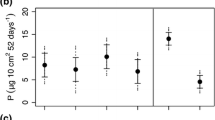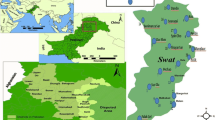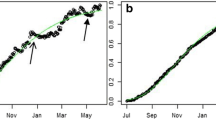Abstract
The growth of forests is the simple sum of the growth rates of all the trees. The growth of individual trees results from non-linear competition among trees for resources, including efficiency in the use of resources to grow stems, and these characteristics may change as trees and forest age. Lodgepole pine (Pinus contorta) forests in Yellowstone National Park showed an unusual pattern of low dominance of large trees (=reverse growth dominance), and we hypothesized this pattern resulted from a pattern of declining resource use efficiency (defined as wood growth per unit of tree leaf area) for large, old trees. Across a 96-site chronosequence, the largest trees continued to increase growth with age. Leaf area increased faster with tree size than did growth, leading to lower growth efficiency for large trees in stands older than about 125 years. These patterns contrasted strongly with those from a similar study with fast-growing Eucalyptus saligna, where strongly positive growth dominance resulted from greater growth efficiency across all sizes and ages. The hypothesis was supported, as the reverse growth dominance was associated with declining resource use efficiency in large, old lodgepole pine trees. Several factors may contribute to the declining growth efficiency of large, old pines, and the contribution of these potential factors could be determined from further investigation.




Similar content being viewed by others
References
Assmann E. 1970. The principles of forest yield study. Oxford: Pergamon Press. p 506p.
Binkley D. 2004. A hypothesis about the interaction of tree dominance and stand production through stand development. For Ecol Manage 190:265–71.
Binkley D, Campoe OC, Gsalptl M, Forrester D. 2013. Light absorption and use efficiency in forests: Why patterns differ for trees and stands. For Ecol Manage 288:5–13.
Binkley D, Ryan MG, Stape JL, Barnard H, Fownes J. 2002. Age-related decline in forest ecosystem growth: An individual-tree, stand-structure hypothesis. Ecosystem 5:58–67.
Binkley D, Senock R, Bird S, Cole T. 2003. Twenty years of stand development in pure and mixed stands of Eucalyptus saligna and nitrogen-fixing Falcataria moluccana. For Ecol Manage 182:93–102.
Binkley D, Stape JL, Bauerle WL, Ryan MG. 2010. Explaining growth of individual trees: Light interception and efficiency of light use by Eucalyptus at four sites in Brazil. For Ecol Manage 259:1704–13.
Binkley D, Kashian DM, Boyden S, Kaye MW, Bradford JB, Arthur MA, Fornwalt PJ, Ryan MG. 2006. Patterns of growth dominance in forests of the Rocky Mountains, USA. For Ecol Manage 236:193–201.
Bond B. 2000. Age-related changes in photosynthesis of woody plants. Trends Plant Sci 5:349–53.
Bradford JB, D’Amato AW, Palik BJ, Fraver S. 2010. A new method for evaluating forest thinning: Growth dominance in managed Pinus resinosa stands. Can J For Res 40:843–9.
Campoe OC, Stape JL, Albaugh TJ, Allen HL, Fox TR, Rubilar R, Binkley D. 2013. Fertilization and irrigation effects on tree level aboveground net primary production, light interception and light use efficiency in a loblolly pine plantation. For Ecol Manage 288:14–20.
Canham CD, Papaik MJ, Uriarte M, McWilliams WH, Jenkins JC, Twery MJ. 2006. Neighborhood analyses of canopy tree competition along environmental gradients in New England forests. Ecol Appl 16:540–4.
Doi BT. 2008. Patterns of growth dominance and neighborhood effects in eucalyptus plantations and tropical forests. PhD dissertation, Colorado State University. 95p.
Doi BT, Binkley D, Stape JL. 2010. Does reverse growth dominance develop in old plantations of Eucalyptus saligna? For Ecol Manage 259:1815–18.
Domec J-C, Gartner BL. 2003. Relationship between growth rates and xylem hydraulic characteristics in young, mature and old-growth ponderosa pine trees. Plant Cell Environ 26:471–83.
Fernández ME, Tschieder EF, Letourneau F, Gyengea JE. 2011. Why do Pinus species have different growth dominance patterns than Eucalyptus species? A hypothesis based on differential physiological plasticity. For Ecol Manage 261:1061–8.
Fernández Tschieder E, Fernández ME, Schlichter TM, Pinazo MA, Crechi EH. 2012. Influence of growth dominance and individual tree growth efficiency on Pinus taeda stand growth. A contribution to the debate about why stands productivity declines. For Ecol Manage 277:116–23.
Gspaltl M, Bauerle W, Binkley D, Sterba H. 2013. Leaf area and light use efficiency patterns of Norway spruce under different thinning regimes and age classes. For Ecol Manage 288:49–59.
Gspaltl M, Sterba H, O’Hara KL. 2012. The relationship between available area efficiency and area exploitation index in an even-aged coast redwood (Sequoia sempervirens) stand. Forestry 85:567–77.
Kashian DM, Romme WH, Tinker DB, Turner MG, Ryan MG. 2013. Postfire changes in forest carbon storage over a 300-year chronosequence of Pinus contorta-dominated forests. Ecol Monogr 83:49–66.
Kashian DM, Turner MG, Romme WH, Lorimer CG. 2005. Variability and convergence in stand structural development on a fire-dominated subalpine landscape. Ecology 86:643–54.
Kaufman MR, Troendle CA. 1981. The relationship of leaf area and foliage biomass to sapwood conducting area in four subalpine forest tree species. For Sci 27:477–82.
Koch GW, Sillett SC, Jennings GM, Davis SD. 2004. The limits to tree height. Nature 424:851–4.
Körner . 2003. Carbon limitation in trees. J Ecol 91:4–17.
Litton CM, Ryan MG, Tinker DB, Knight DH. 2003. Belowground and aboveground biomass in young postfire lodgepole pine forests of contrasting tree density. Can J For Res 33:351–63.
Litton CM, Ryan MG, Knight DH. 2004. Effects of tree density and stand age on carbon allocation patterns in postfire lodgepole pine. Ecol Appl 14:460–75.
Mainwaring DB, Maguire DA. 2004. The effect of local stand structure on growth and growth efficiency in heterogeneous stands of ponderosa pine and lodgepole pine in central Oregon. Can J For Res 34:2217–29.
Martin TA, Jokela EJ. 2004. Developmental patterns and nutrition impact radiation use efficiency components in southern pine stands. Ecol Appl 14:1839–54.
McDowell NG, Bond BJ, Dickman LK, Ryan MG, Whitehead D. 2011. Relationships between tree height and carbon isotope discrimination. In: Meinzer FC, Dawson TE, Lachenbruch B, Eds. Size- and age-related changes in tree structure and function. New York: Springer. p 255–86.
Pothier D, Margolis HA, Poliquin J, Waring RH. 1989. Relation between the permeability and the anatomy of jack pine sapwood with stand development. Can J For Res 19:1564–70.
Pretzsch H, Biber P. 2010. Size-symmetric versus size-asymmetric competition and growth partitioning among trees I forest stands along an ecological gradient in central Europe. Can J For Res 40:370–84.
Ryan MG, Binkley D, Fownes JH. 1997. Age-related decline in forest productivity: Pattern and process. Adv Ecol Res 27:213–62.
Smith FW, Resh SC. 1999. Age-related changes in production and below-ground carbon allocation in Pinus contorta forests. For Sci 45:333–41.
Stape JL, Binkley D, Ryan MG. 2004. Eucalyptus production and the supply, use and the efficiency of use of water, light and nitrogen across a geographic gradient in Brazil. For Ecol Manage 193:17–31.
Stephenson NL, Das AJ, Condit R, Russo SE, Baker PJ, Beckman NG, Coomes DA, Lines ER, Morris WK, Rüger N, Álvarez E, Blundo C, Bunyavejchewin S, Chuyong G, Davies SJ, Duque Á, Ewango CN, Flores O, Franklin JF, Grau HR, Hao Z, Harmon ME, Hubbell SP, Kenfack D, Lin Y, Makana R, Malizia A, Malizia LR, Pabst J, Pongpattananurak N, Su SH, Sun IF, Tan S, Thomas D, van Mantgem PJ, Wang X, Wiser SK, Zavala MA. 2014. Rate of tree carbon accumulation increases continuously with tree size. Nature . doi:10.1038/nature12914.
Walcroft AS, Silvester WB, Grace JC, Carson SD, Waring RH. 1996. Effects of branch length on carbon isotope discrimination in Pinus radiata. Tree Physiol 16:281–6.
Waring RH. 1983. Estimating forest growth and efficiency in relation to canopy leaf area. Adv Ecol Res 13:327–54.
Waring RH, Silvester WB. 1994. Variation in d13C values within the tree crowns of Pinus radiata. Tree Physiol 14:1203–13.
Waring RH, Thies WG, Muscato D. 1980. Stem growth per unit of leaf area: A measure of tree vigor. For Sci 26:112–17.
Acknowledgments
We thank the many people who contributed to the broader study of lodgepole pine in Yellowstone National Park, especially Bill Romme, Monica Turner, Dan Tinker, Mike Ryan, and Creighton Litton. Much of that work was funded by the Joint Fire Sciences Program (Project Number 03-1-1-06), with additional support from Colorado State University and Wayne State University. Richard Waring, Nathan Stephenson, Christian Ammer, and an anonymous reviewer helped us improve the manuscript substantially.
Author information
Authors and Affiliations
Corresponding author
Additional information
Author contributions
Dan Binkley developed the assessment of individual tree growth and leaf area, based on data developed in projects led by Dan Kashian. Both authors contributed to data analysis and writing.
Rights and permissions
About this article
Cite this article
Binkley, D., Kashian, D.M. Tree-Level Patterns of Lodgepole Pine Growth and Leaf Area in Yellowstone National Park: Explaining Anomalous Patterns of Growth Dominance Within Stands. Ecosystems 18, 251–259 (2015). https://doi.org/10.1007/s10021-014-9823-z
Received:
Accepted:
Published:
Issue Date:
DOI: https://doi.org/10.1007/s10021-014-9823-z




